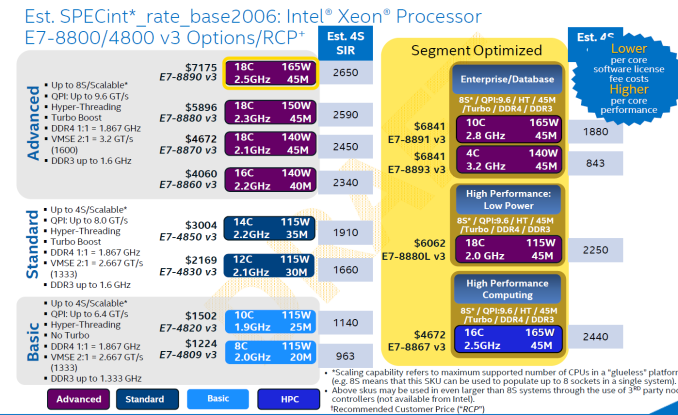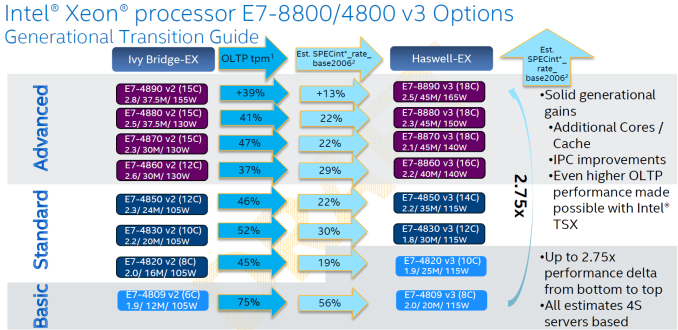The Intel Xeon E7-8800 v3 Review: The POWER8 Killer?
by Johan De Gelas on May 8, 2015 8:00 AM EST- Posted in
- CPUs
- IT Computing
- Intel
- Xeon
- Haswell
- Enterprise
- server
- Enterprise CPUs
- POWER
- POWER8
Xeon E7 v3 SKUs and prices
Intel SKU list has always been complex and very long. For reference, this is what the Xeon E7 v2 line-up looked like when it launched in 2014:
There is a scalable 2S line that is not scalable beyond 2 sockets, a frequency optimized 8857 which is probably faster in many applications than the 8893 and so on.
Luckily, with the introduction of the Xeon E7 v3, Intel simplified the SKU list.
First of all, the hardly scalable 2 socket version is gone. And at the low-end, you now get a 8-core processor at 2 GHz instead of a 6-core at 1.9 GHz. Well done, Intel.
The high-end models are all capable of running in 8 socket configurations. But the enterprise people looking for a high-end quad socket system have to pay a bit more: about 8 to 10%. Most enterprise people will not care, but getting 20% more cores (slightly improved) at 8-10% lower clocks while paying about 8% more is not exactly a vast improvement. Of course these are paper specs, but Intel used to be (a lot) more generous.
Intel's own slides confirm this. The gains in SPECint2006_rate are pretty small to justify the price increase. Intel claims higher OLTP (TPC-C) increases, but the mentioned gains are rather optimistic. For example, the HammerDB benchmark runs 29% faster on the E7-8890 v3 than on the E7-4890v2. This benchmark is much more transparant, straight forward and easier to reproduce than TPC-C, so we feel it is probably closer to the real world. Secondly, in both cases (HammerDB and TPC-C), the E7-8890v3 had twice as much memory (1 TB vs 512 GB) memory as its predecessor.
Lastly, these are benchmarks after all. In the real world systems are not running at full speed, so the gains are much smaller. So it seems that in most applications besides the TSX/AVX2 enabled ones, the gains will be rather small.













146 Comments
View All Comments
MyNuts - Tuesday, May 12, 2015 - link
Charles Babbage would be upsetquadibloc - Thursday, May 14, 2015 - link
I'm shocked to hear that Oracle and IBM are charging more for their SPARC and PowerPC chips, respectively, than Intel is charging for comparable x86 chips - or, at least, I presume they are, if servers using those chips are more expensive. Since x86 has the enormous advantage of being able to run Microsoft Windows, the only way other ISAs can be viable is if they offer better performance or a lower price.Kevin G - Thursday, May 14, 2015 - link
Actually IBM comes in cheaper than Intel for comparable POWER8 hardware. IBM now is offering the processor to outside system builders so the actual prices are some what known. Tyan used to have the raw prices on their site but I can't find them again.Regardless, this article indicates that they top out at $3000 which is less than equivalent Xeon E7's.
kgardas - Thursday, May 21, 2015 - link
Sure, SPARC and POWER are (was in case of POWER) more expensive, but usually hardware price is nothing in comparison with software price if you are running enterprise. Also SPARC is also Oracle preferred over POWER/Itanium by Oracle's price ratios... Anyway, POWER8 looks so powerful that it may even be cheaper software wise in comparison with SPARC, but that would need some clever Oracle DB benchmarking...HighTech4US - Friday, May 15, 2015 - link
Power 9 will be available when?Phiro69 - Friday, May 15, 2015 - link
I wanted to compare the E7's in this review to the E5's reviewed a few months back in your benchmark comparison tool, but I'm not seeing any of this data in it? Is it going to be there?